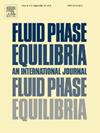Experimental and theoretical investigation of CO2 solubility in amine-based deep eutectic solvents
Abstract
Deep eutectic solvents (DESs) have appealed increasing research interest across various scientific and industrial applications, notably in relation to efforts in CO2 capture. This study presents a novel series of DESs were synthesized on the basis of monoethanolamine (MEA) and N-methyldiethanolamine (MDEA) as hydrogen bond donors with tetrabutylammonium bromide (TBAB) and tetrabutylphosphine bromide (TBPB) salt as hydrogen bond acceptors. A gas solubility measurement experimental system based on pressure drop method has been established to evaluate the solubility of CO2 in amine-based deep eutectic solvents. The evaluation was performed over a temperature range of 303.15 to 323.15 K and a pressure range of 100 to 1000 kPa. The results indicated that as the molar ratio of hydrogen bond donors increases, the solubility of CO2 in DESs increases, while it was found to be less affected by the hydrogen bond acceptor. Of these, the solubility of CO2 is strongest at a 1:10 molar ratio of TBAB and MEA. The nuclear magnetic resonance spectroscopy spectra (NMR) and FTIR spectroscopy revealed that the MEA-based DES mixture primarily exhibited chemical absorption of CO2, while the MDEA-based DES predominantly showed physical dissolution of CO2. In addition, it was observed that both temperature and pressure significantly influenced the CO2 solubility, and a successful correlation was developed using different semi-empirical models.

 求助内容:
求助内容: 应助结果提醒方式:
应助结果提醒方式:


